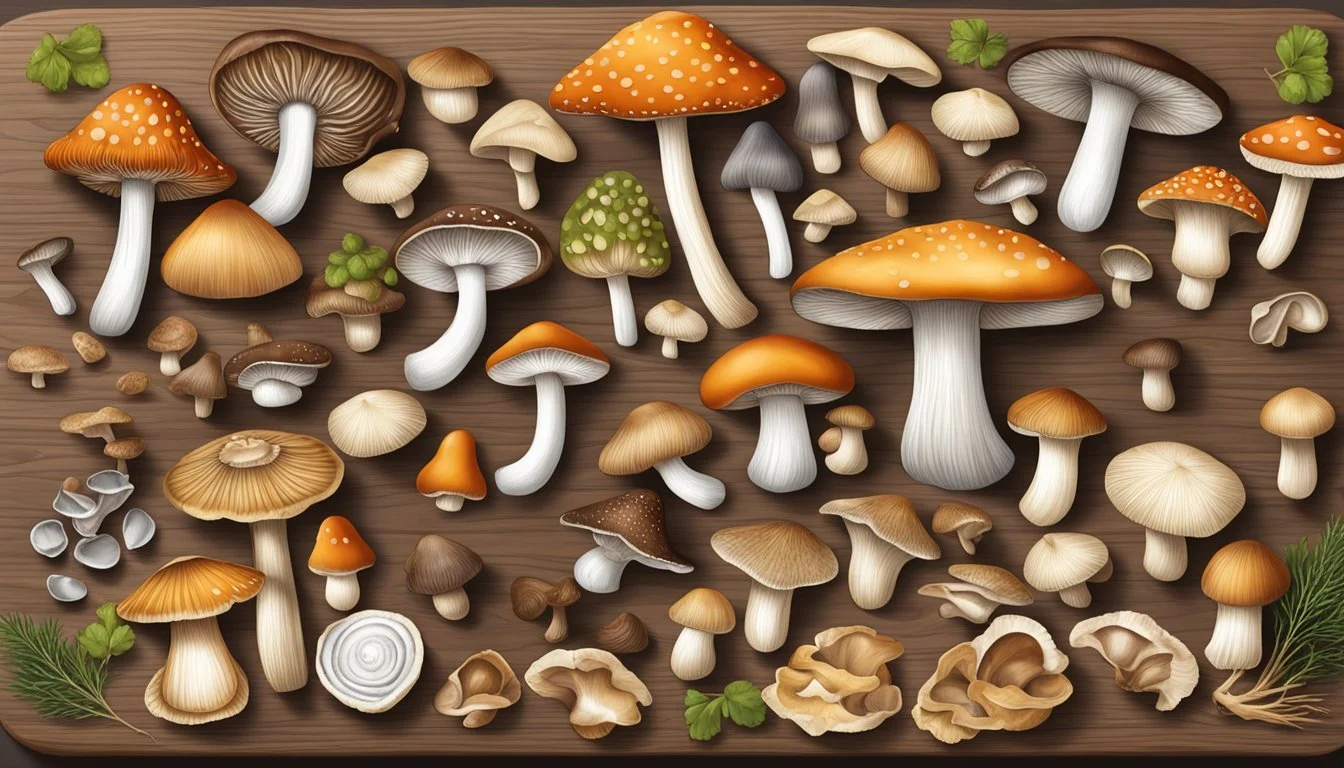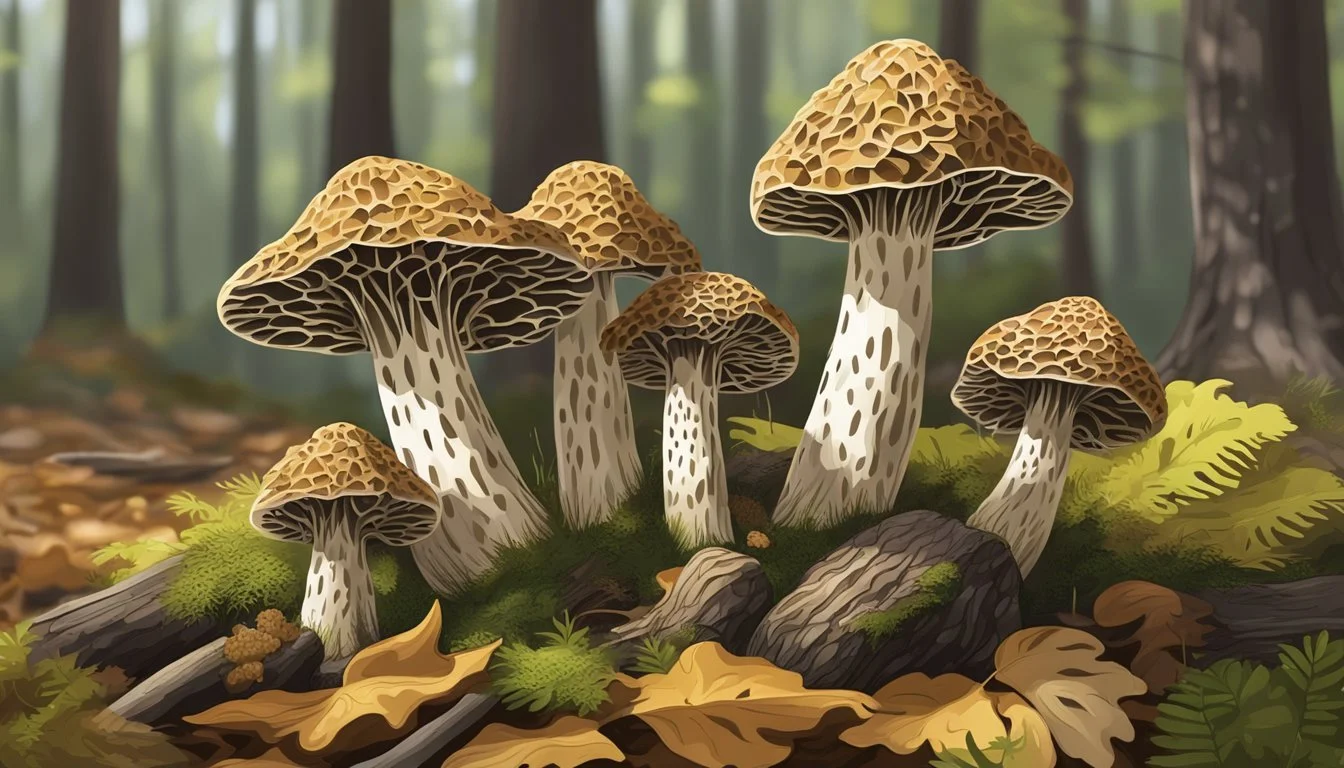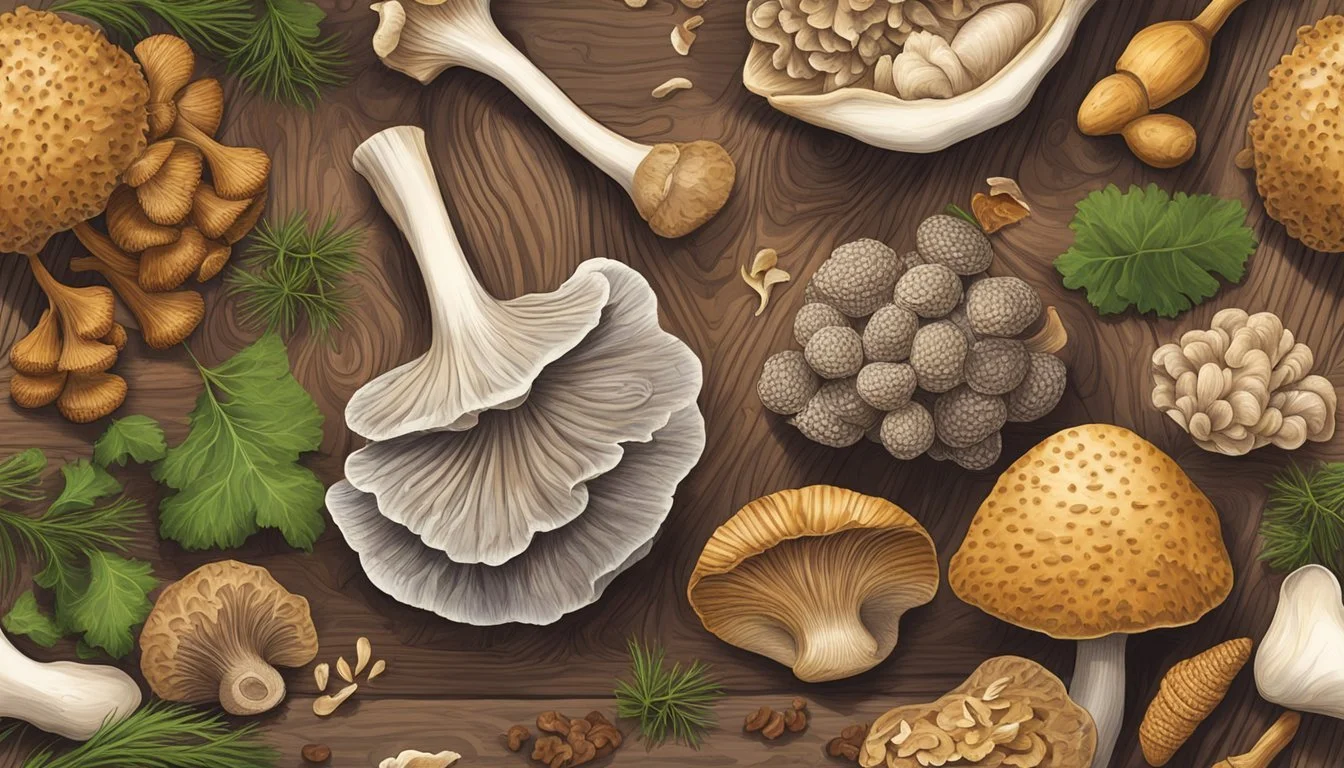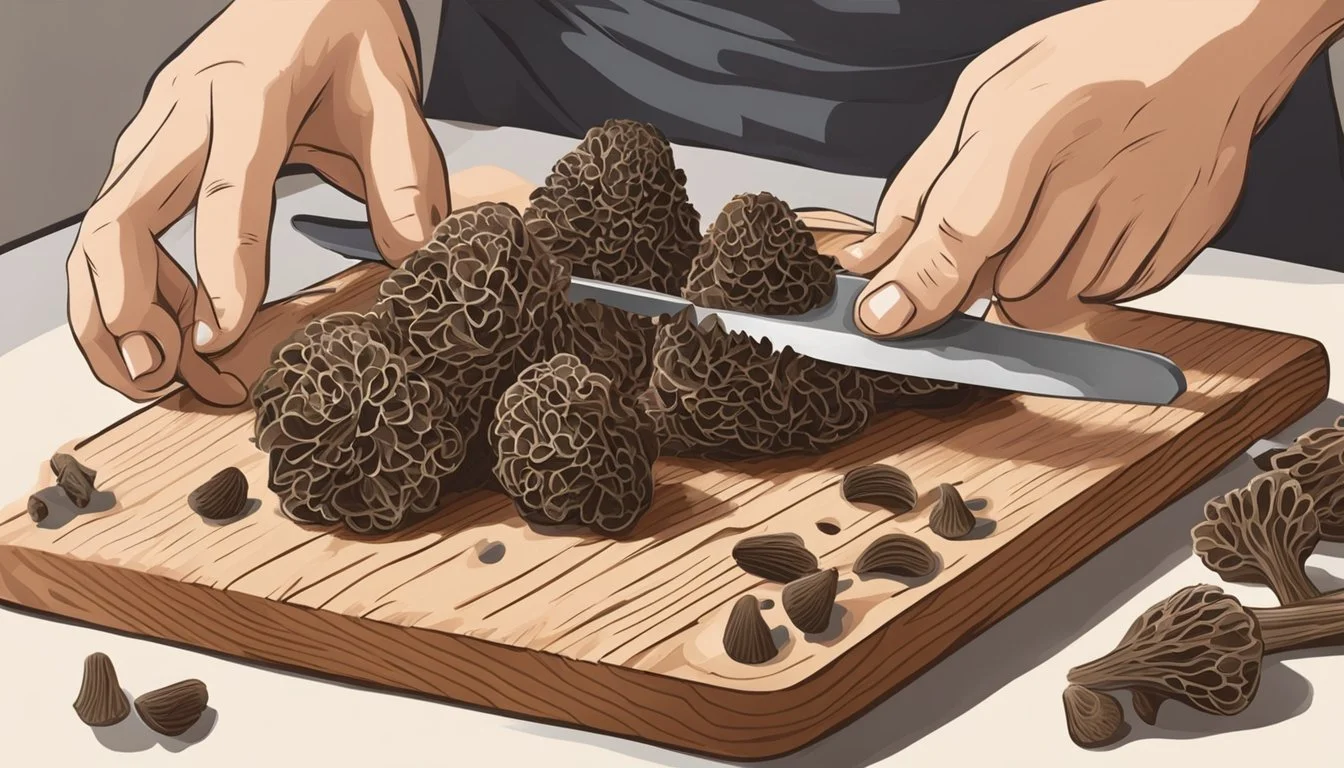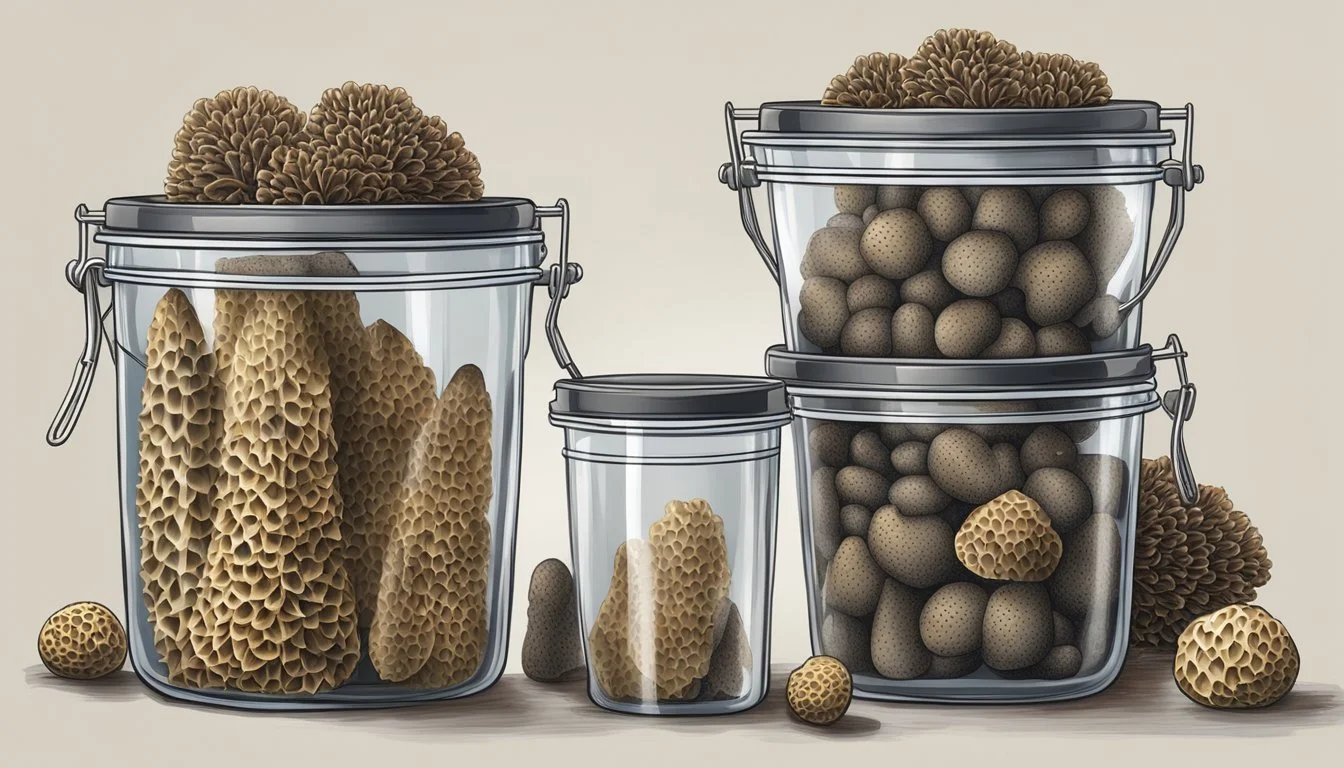Morel Mushrooms Substitutes
Top Alternatives for Your Recipes
For those who savor the unique taste of morel mushrooms but occasionally find them difficult to source, there are several excellent substitutes that can be used in various culinary creations. Black trumpet mushrooms offer a rich, smoky flavor and a delicate texture similar to morels. They can be used in equal amounts, making them a convenient alternative.
Another outstanding option is the oyster mushroom, known for its mild, slightly sweet flavor and soft, tender texture. Oyster mushrooms come in various shades, from white to pale gray or light brown, and seamlessly blend into dishes where morels would typically shine.
Maitake mushrooms, or hen-of-the-woods, provide a bouquet-shaped appearance and an earthy flavor profile. These wild mushrooms are frequently used in Asian cuisines and can wonderfully mimic the taste and texture of morels, making them a versatile addition to any recipe calling for morel mushrooms.
Understanding Morel Mushrooms
Morel mushrooms are a prized find in culinary circles, notable for their unique appearance and rich, earthy flavor. Known for thriving in wild, wooded environments, morels offer both visual and culinary appeal.
Characteristics of Morels
Morels are distinct due to their honeycomb-like appearance. Their caps appear ridged and pitted, ranging in color from light tan to dark brown. Inside, morels are typically hollow, which helps in identifying them against false morels that have a more solid or chambered interior.
These mushrooms grow usually in wild, wooded areas, often at the base of trees such as elm, ash, and oak. Morels produce light, cream-colored spores, a crucial identifying feature. They have a rich, earthy taste that makes them a sought-after ingredient in gourmet cooking.
Culinary Uses
In cooking, morels are celebrated for their savory, earthy flavor that works well in a variety of dishes. They are commonly used in sauces, soups, and as an accompaniment to meats. Morels can be stuffed, sautéed, or incorporated into recipes for a depth of flavor.
When preparing morels, it's essential to clean them thoroughly to remove any grit or dirt trapped in their ridges. Blanching and quick cooling in ice water can help preserve their texture and color. Their unique flavor makes them a favorite in traditional and gourmet recipes alike.
Common Substitutes for Morel Mushrooms
Morel mushrooms are known for their unique flavor and texture, making them a favorite among culinary enthusiasts. When morels are unavailable, several other mushrooms can serve as excellent substitutes, each bringing their own characteristics to dishes.
Oyster Mushrooms
Oyster mushrooms are among the top substitutes due to their mild, slightly sweet flavor and soft, tender texture. They can be found in various colors, from white to light brown.
These mushrooms are versatile and can be used in many recipes that call for morels. Their delicate texture makes them ideal for sautés, soups, and stir-fries. To use oyster mushrooms as a morel substitute, replace them in equal amounts.
Here is a table comparing key attributes:
Attribute Morel Mushrooms Oyster Mushrooms Flavor Earthy, nutty Mild, sweet Texture Spongy, hollow Tender, soft Color Brown White to brown
Shiitake Mushrooms
Shiitake mushrooms are another excellent substitute with their rich, umami flavor and meaty texture. These mushrooms can enhance the depth of flavor in various dishes, making them a strong alternative to morels.
Shiitakes are often used in soups, stews, and sauces. Their dense texture holds up well to cooking, adding a satisfying bite. When substituting shiitake mushrooms for morels, use them in a 1:1 ratio.
For comparison:
Attribute Morel Mushrooms Shiitake Mushrooms Flavor Earthy, nutty Umami, rich Texture Spongy, hollow Meaty, firm Color Brown Brown, tan
Porcini Mushrooms
Porcini mushrooms, especially in their dried form, offer a robust and earthy flavor with a meaty texture that makes them a great replacement for morels.
They are particularly well-suited for use in sauces, risottos, and soups. To rehydrate dried porcini mushrooms, soak them in warm water for about 20 minutes before using. This process enhances their flavor, making them a potent substitute.
Comparative table:
Attribute Morel Mushrooms Porcini Mushrooms Flavor Earthy, nutty Earthy, robust Texture Spongy, hollow Meaty, dense Color Brown Brown
Using these common substitutes can help maintain the integrity and richness of recipes that traditionally feature morel mushrooms. The choice of substitute depends on the desired flavor profile and texture in the dish.
Other Flavorful Mushroom Varieties
Different mushroom varieties bring unique flavors and textures to dishes. Some stand out for their richness, earthiness, or subtle notes, making them excellent alternatives to morel mushrooms.
Chanterelle Mushrooms
Chanterelle mushrooms are known for their bright orange or yellow color and trumpet-like shape. They have a fruity aroma with hints of apricot and a peppery taste. These mushrooms are prized in many cuisines for their ability to enhance dishes with their rich, complex flavors.
Often found in European, Asian, and North American forests, chanterelles thrive in moist, shaded environments. Due to their delicate texture, it's best to cook them gently, such as by sautéing or adding them to creamy sauces.
Cremini and Button Mushrooms
Cremini mushrooms, sometimes called baby bellas, are often seen as a middle ground between white button mushrooms and portobellos. With a slightly deeper flavor than their white counterparts, they offer a meaty texture that's versatile in a variety of dishes.
Button mushrooms, or white buttons, have a mild taste and firm texture. These mushrooms are widely available and cost-effective, making them a staple in many kitchens. Both varieties work well in soups, stews, and as toppings for pizzas and salads, providing a subtle flavor boost without overpowering other ingredients.
Maitake Mushrooms
Known as hen of the woods mushrooms, maitake mushrooms have a feathery appearance and grow in clusters. They possess a strong, earthy flavor with a slight spiciness, making them a favorite in Japanese and Chinese cuisine.
Maitake can be grilled, roasted, or sautéed, enhancing their robust taste. Their crisp-tender texture makes them a standout in stir-fries, and they can also be used in soups and stews for added depth. These mushrooms are often valued for their unique health benefits, including potential immune-boosting properties.
Specialized Mushroom Substitutes
The search for substitutes for morel mushrooms can lead to several interesting and specialized alternatives. Varieties suitable for Asian cuisine, European delicacies, and a comparison of cultivated versus wild varieties are explored.
Asian Cuisine Staples
Shiitake mushrooms are a prized ingredient in Asian cuisine. Their rich, umami flavors make them a perfect substitute for morels in dishes like stir-fries and soups.
Maitake mushrooms, also known as Hen-of-the-Woods, offer an earthy, delicate texture ideal for Japanese and Chinese cooking. Maitake pairs well with meats and vegetables, adding depth and flavor.
Oyster mushrooms are widely used in Asian dishes due to their mild, slightly sweet taste and tender texture. They work beautifully in stir-fries, enhancing the dish without overpowering other ingredients.
European Delicacies
In European culinary traditions, certain substitutes can closely mimic the unique characteristics of morels. Chanterelles, known for their golden color and peppery flavor, are often found near oak trees, much like morels. They are a popular choice in French and Italian cuisine, enhancing risottos and sauces.
Porcini mushrooms have a dense, meaty texture and a nutty taste, making them an excellent ingredient in European dishes like risottos and stews.
Black trumpet mushrooms offer a rich, smoky flavor, providing a distinct, gourmet twist to European-styled recipes, especially game dishes.
Cultivated vs. Wild Varieties
The distinction between wild and cultivated mushrooms can significantly impact flavor and texture. Wild mushrooms, like morels, chanterelles, and black trumpets, often have more intense flavors and unique textures due to their natural growing conditions.
On the other hand, cultivated varieties such as shiitake and portobello mushrooms provide a more consistent and readily available option. Shiitake mushrooms, for instance, offer robust umami flavors suitable for a variety of dishes.
Portobello mushrooms are highly versatile, with a meaty texture that makes them an excellent replacement for morels in hearty recipes, such as grilled or stuffed preparations.
Understanding these differences helps in choosing the right mushroom substitute for specific culinary needs, ensuring both flavor and texture are preserved in the dish.
Preparing Mushroom Substitutes
Proper preparation of mushroom substitutes ensures that they deliver the best texture and flavor to your dishes. This includes rehydrating dried varieties and using suitable cooking techniques for different textures.
Rehydrating Dried Varieties
To rehydrate dried mushrooms, such as dried chanterelles or dried black trumpets, soak them in warm water for 20-30 minutes. Make sure they are fully submerged. Once rehydrated, drain and rinse them gently under cold water to remove any grit.
Pat them dry with a paper towel. For extra flavor, save the soaking liquid and use it as a base for soups or sauces. Strain the liquid through a fine sieve or a coffee filter to remove any sediment.
Cooking Techniques for Different Textures
For mushrooms with delicate textures like oyster mushrooms, sautéing in butter or olive oil over medium heat for 5-7 minutes is ideal. This method preserves their tender quality while enhancing their mild flavor.
Thicker mushrooms such as maitake or baby bellas benefit from pan-frying or roasting. Pan-fry them in a hot skillet for 8-10 minutes until they are golden brown. Alternatively, roast them at 375°F for 20-25 minutes to bring out a meaty texture and rich flavor.
For grilling, brush mushrooms lightly with oil and grill over medium-high heat for 4-6 minutes per side. This technique works well for larger mushroom varieties like portobellos and king oysters.
Focusing on these preparation methods ensures that mushroom substitutes perform well in place of morels. These techniques highlight their unique textures and flavors effectively.
Non-Mushroom Alternatives
Finding a suitable replacement for morel mushrooms can be crucial for those with dietary restrictions or availability issues. Non-mushroom alternatives provide different flavors and textures, making them viable options in various recipes.
Vegetable Options
Zucchini is a versatile vegetable that works well as a substitute. When sliced and sautéed, it offers a soft texture that mimics cooked mushrooms. Its mild flavor doesn't overpower dishes and blends well with other ingredients.
Eggplant has a meaty texture similar to mushrooms. Its ability to absorb flavors makes it an excellent option for stews and stir-fries. Light seasoning and proper cooking render it tender and savory.
Cauliflower can be chopped finely to replicate the texture of mushrooms. It's particularly useful in dishes like risottos and casseroles. Roasting or sautéing brings out its nutty flavor, providing depth to the dish.
Broccoli, when finely chopped, offers a crunchy texture. While it doesn't mimic the earthy taste of mushrooms, it provides a fresh, vegetal note. It's best used in stir-fries and salads.
Using Nutritious Substitutes
Tempeh is a nutritious, high-protein alternative. Made from fermented soybeans, it has a firm texture and nutty flavor. When diced and sautéed, it serves as a hearty addition to various dishes like soups and pasta.
Tofu is another protein-rich option. Its bland taste allows it to absorb flavors from spices and sauces. Crumbling or cubing tofu and adding it to recipes can create a satisfying substitute for mushrooms.
Nuts and seeds offer crunch and flavor. Chopped walnuts or sunflower seeds can be sprinkled over dishes to add texture. They don't replicate the mushroom's taste but contribute to the overall complexity of the dish.
Legumes, such as lentils, provide a nutritious boost. Cooked lentils have a slightly earthy flavor and can be used in soups, stews, and salads. They are an excellent source of protein and fiber, making them a valuable addition.
Health and Safety Considerations
When foraging for morel mushroom substitutes, paying attention to safety measures and understanding nutritional differences are essential. Identifying false morels and knowing the nutritional value of alternative mushrooms can ensure a safe and wholesome foraging experience.
Identifying False Morels
False morels, such as those from the Gyromitra genus, are often mistaken for edible morels. These mushrooms contain toxic compounds like gyromitrin, which can lead to severe health issues, including nausea and neurological damage.
One key distinction is their appearance. False morels have a more irregular, lobed, or folded cap, unlike the true morel’s honeycomb-like surface. Additionally, while true morels are hollow inside, false morels have a cotton-like substance within the stem. Proper identification is crucial to avoid the risks associated with consuming these poisonous mushrooms.
Nutritional Profiles
When considering substitutes for morel mushrooms, understanding their nutritional profiles is beneficial. Morels are rich in fiber, vitamins, and minerals, which makes them a healthy choice. Morel substitutes like maitake or hen-of-the-woods also offer significant nutritional value, containing similar levels of beneficial nutrients.
For instance:
Maitake Mushrooms: High in fiber, B vitamins, and antioxidants.
Chanterelles: Rich in vitamin D and potassium.
Porcini Mushrooms: Good source of protein, dietary fiber, and several vitamins.
Comparing these nutritional values helps foragers make informed decisions about safe and nutritious mushroom alternatives.
Storing and Preserving Substitutes
Proper storage and preservation methods can significantly extend the shelf life of morel mushroom substitutes while maintaining their flavor and texture. Key techniques include drying, refrigerating, and blanching. Each method has its specific steps and benefits.
Proper Storage Techniques
To store substitutes like Maitake, Black Trumpet, or Oyster Mushrooms properly, refrigeration is often the best method. Place fresh mushrooms in a paper bag to absorb excess moisture and store them in the refrigerator. Don't wash the mushrooms before storing them as excess water can lead to quicker spoilage.
For dried substitutes like dried porcini mushrooms, store them in an airtight container in a cool, dark place. This prevents moisture and light from degrading their quality. Dried morel mushrooms can also be stored similarly and rehydrated when needed.
Extending Shelf Life
To extend the shelf life of mushroom substitutes, consider blanching before storage. Blanching Black Trumpet or Oyster Mushrooms involves boiling them for 2-3 minutes, then quickly cooling them in ice water. This process helps maintain color and prevents bacterial growth.
Drying mushrooms like Maitake or Black Trumpet can significantly extend shelf life. Use a food dehydrator or an oven set at a low temperature to remove moisture. Store dried mushrooms in an airtight container to keep them usable for months.
Blanched or dried mushrooms can be stored in freezer-safe bags or containers. Properly stored mushrooms will retain their flavor and texture, making them a versatile choice for various culinary applications.

